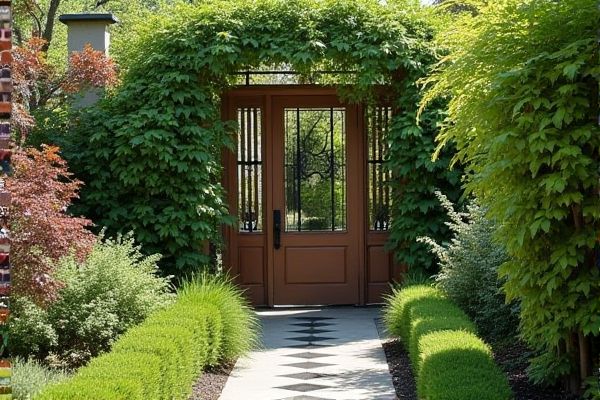
A privacy trellis offers a decorative and flexible solution for enhancing your outdoor space with climbing plants, creating partial visual barriers that blend seamlessly with nature. Explore the rest of the article to discover how privacy walls provide more solid, durable protection and which option best suits your privacy and aesthetic needs.
Table of Comparison
| Feature | Privacy Trellis | Privacy Wall |
|---|---|---|
| Material | Woven wood, bamboo, or metal | Solid wood, concrete, or composite panels |
| Design | Open lattice pattern for partial visibility | Opaque, full coverage for total privacy |
| Height | Typically 4-6 feet | Typically 6-8 feet or higher |
| Purpose | Partial privacy with aesthetic appeal | Maximum privacy and noise reduction |
| Ventilation | Good airflow | Limited airflow |
| Cost | Moderate | Higher due to materials and installation |
| Installation | Easy to moderate | Moderate to complex |
| Maintenance | Low to moderate | Moderate |
Understanding Privacy Trellis and Privacy Wall
Privacy Trellis enhances outdoor space privacy using a lattice framework that supports climbing plants, creating a natural visual barrier. Privacy Wall provides a solid, often opaque structure made from wood, metal, or composite materials to effectively block views and noise. Both solutions improve seclusion, but Privacy Trellis offers a more breathable, decorative feature that blends with landscaping, whereas Privacy Wall emphasizes maximum concealment and durability.
Key Differences: Privacy Trellis vs Privacy Wall
Privacy trellises are typically constructed using lattice frameworks that support climbing plants, offering a semi-transparent barrier that balances privacy with natural light and airflow. In contrast, privacy walls are solid structures made from materials like wood, metal, or concrete, providing complete visual and sound blockage for enhanced seclusion. The primary difference lies in their design intent: privacy trellises emphasize aesthetic integration with greenery and partial visibility, while privacy walls prioritize full privacy and durability.
Materials Used in Privacy Trellis Construction
Privacy trellises are typically constructed from durable materials such as cedar, redwood, vinyl, or metal, offering both strength and weather resistance. Unlike privacy walls that often use concrete, brick, or stone, trellises rely on lightweight yet sturdy materials ideal for supporting climbing plants. Choosing the right materials for your privacy trellis ensures longevity and enhances the overall aesthetic of your outdoor space.
Materials Used in Privacy Wall Design
Privacy walls often utilize sturdy materials such as wood, brick, vinyl, or metal to create a solid barrier that enhances security and noise reduction. In contrast, privacy trellises typically incorporate lighter materials like wood or composite lattice panels designed to support climbing plants, offering a natural and decorative privacy solution. Your choice between these options depends on whether you prioritize durability and complete seclusion or aesthetic appeal combined with greenery.
Installation Process: Trellis vs Wall
Installing a privacy trellis is typically faster and requires less structural work compared to a privacy wall, as trellises often mount directly onto existing fences or posts. Privacy walls demand a more complex installation, involving digging footings, pouring concrete, and assembling heavy materials like wood, brick, or vinyl panels. This difference in installation complexity makes trellises more suitable for quick, cost-effective privacy upgrades, while walls offer a more permanent and robust solution.
Aesthetic Appeal: Trellis vs Wall
A privacy trellis offers a lightweight, visually appealing structure that supports climbing plants, creating a natural and dynamic aesthetic with varying greenery throughout the seasons. In contrast, a privacy wall provides a solid, uniform barrier that delivers consistent visual privacy and can serve as a more permanent architectural feature. Both options enhance outdoor spaces differently, with trellises emphasizing organic beauty and walls emphasizing structural presence.
Privacy Levels: Which Option Offers More Security?
Privacy trellis and privacy wall both enhance outdoor seclusion, but privacy walls offer higher security levels due to their solid, continuous structure that blocks sight and sound more effectively. Privacy trellises use lattice designs that provide moderate privacy while allowing airflow and some visibility, making them less secure against prying eyes. For your maximum privacy needs and enhanced protection from intrusions, a privacy wall is the superior option.
Cost Comparison: Privacy Trellis vs Privacy Wall
Privacy trellises are generally more cost-effective than privacy walls due to lower material and installation expenses, making them suitable for budget-conscious homeowners. Privacy walls involve higher upfront costs because of the need for durable construction materials like concrete, brick, or treated wood and professional labor. Long-term maintenance costs also favor privacy trellises, which typically require less upkeep compared to the frequent repairs and painting that privacy walls demand.
Maintenance Requirements for Each Option
Privacy trellises require regular upkeep including pruning, cleaning, and inspection to prevent damage and support healthy plant growth, which directly impacts their effectiveness as natural barriers. Privacy walls demand less frequent maintenance, mostly involving occasional cleaning, repainting, or repairs to address weather-related wear and structural issues. You should consider your available time and resources for maintenance when choosing between a privacy trellis and a privacy wall to ensure long-term privacy and durability.
Choosing the Right Privacy Solution for Your Outdoor Space
Privacy trellises offer a versatile and decorative solution that enhances your outdoor space by supporting climbing plants and creating a natural screen. Privacy walls provide a more solid and durable barrier, ensuring maximum seclusion and noise reduction for your backyard or garden. Your choice depends on the balance between aesthetics, privacy level, and maintenance preferences.
 homyna.com
homyna.com